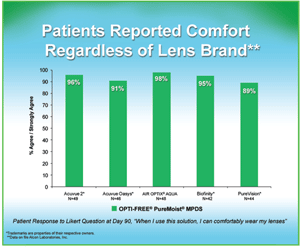Growing our contact lens patient base in the era of the hyper-informed and hyper-critical patient means that we, as practitioners, need to deliver better products and better solutions in response to our patients’ demand for good vision and comfort throughout their day—from insertion to removal of their contact lenses, as long as they wear them.
Keep in mind that expanding our patient base is as much about keeping our current patients in contact lenses as it is about attracting new contact lens wearers. When polled, patients around the world named comfort as their primary reason for dropping out of contact lens wear.1
Silicone hydrogel contact lenses have been at the forefront of this issue; the increase in their use over the past decade shows that practitioners have noticed the advantages of the material.2 However, in that same time, we have continued to see the same number of dropouts from contact lenses, so the material itself does not seem to be the solution to the comfort problem.1
The Solution
Over time, we have all seen symptomatic patients who come back looking for better comfort—they are vocal and easy to spot. Many contact lens solutions make claims about the symptomatic patient, and we, as practitioners, are wired to the “problem-based” eye exam. Having a solution that can make that patient that is not complaining more comfortable is tantamount to curtailing the contact lens dropout issue that our practices face, as well as creating value for those in our practice who have good comfort but could see enhanced comfort from a better solution or product.
 Silicone hydrogel materials are by nature hydrophobic. The manufacturing processes in transforming these hydrophobic materials into something that is compatible with the ocular surface differ between the companies. These soft lenses will have a hydrophobic backbone that start out with hydrophilic sites on their lens surface. With some silicone hydrogel materials the tear film breaks up, and the hydrophilic groups can migrate into the lens producing a more hydrophobic, less-wettable surface.3 Maintaining lens wettability is a challenge with all contact lenses, but especially with silicone hydrogels.
Silicone hydrogel materials are by nature hydrophobic. The manufacturing processes in transforming these hydrophobic materials into something that is compatible with the ocular surface differ between the companies. These soft lenses will have a hydrophobic backbone that start out with hydrophilic sites on their lens surface. With some silicone hydrogel materials the tear film breaks up, and the hydrophilic groups can migrate into the lens producing a more hydrophobic, less-wettable surface.3 Maintaining lens wettability is a challenge with all contact lenses, but especially with silicone hydrogels.
To help us with this battle for comfort, Alcon has introduced OPTI-FREE® PureMoist® multipurpose disinfecting solution. A novel block copolymer, HydraGlyde® Moisture Matrix improves the wettability of silicone hydrogels by impacting both the lens surface and bulk hydrating properties. With its affinity for both internal and external siloxan groups, HydraGlyde® Moisture Matrix decreases the hydrophobic nature of silicone hydrogel lenses.4 This can lead to better comfort experience for your patients.4
The Research
Alcon has conducted many studies to assess solution’s performance in the symptomatic patient. However, the non-complaining patient is the one who may benefit from doctors being proactive in recommending solutions that may enhance comfort. Alcon conducted a study of asymptomatic patients with OPTI-FREE® PureMoist® MPDS which showed statistically significant improvements over the comparator in the patient’s perceptions of all day comfort and the ability to wear lenses that feel moist from lens insertion to removal. Patients also reported outstanding comfort across all contact lens brands tested, silicone hydrogel or traditional hydrogel.5
Having a solution that provides patient comfort, regardless of lens type, allows the practitioner to make strong solution recommendations for their patients. Patients have a lot of solution choices when they go shopping. Giving patients a compelling reason to use a particular solution is tantamount to keeping them comfortable and happy in their lens wear. A product that does this in the asymptomatic patient is even more of a practice enhancer. Recommending a product that provides comfort, while utilizing the exceptional dual disinfection that the OPTI-FREE® brand is known for, will help keep your patients happy and successful in their lenses.
1. Rumpakis J. New data on contact lens dropouts: an international perspective. Rev Optom. 2010 Jan;147(1):37-44
2. Morgan PB, Efron N, Helland M, et al. Twenty first century trends in silicone hydrogel contact lens fitting: an international perspective. Cont Lens Anterior Eye. 2010 Aug;33(4):196-8.
3. Epstein A, Stone R. Surface and polymer chemistry: the quest for comfort. Rev Cornea Cont Lens. 2010 Apr;247(1):15-19.
4. Davis JW, Ketelson HA, Shows A, Meadows DL. A lens care solution designed for wetting silicone hydrogel materials. Invest Ophthalmol Vis Sci. 2010;51:E-Abstract 3417
5. Data on file. Alcon Research Ltd. 2011


